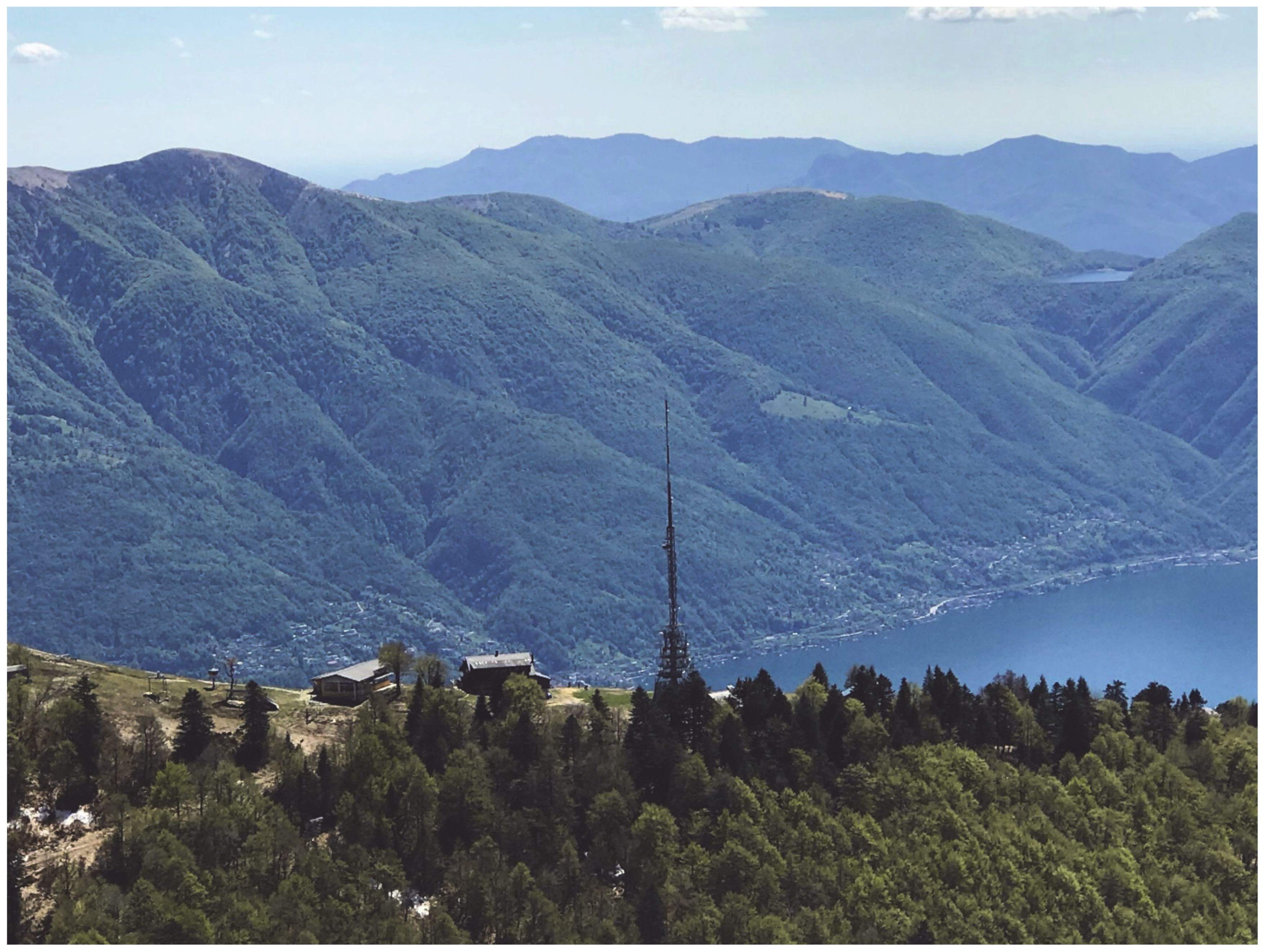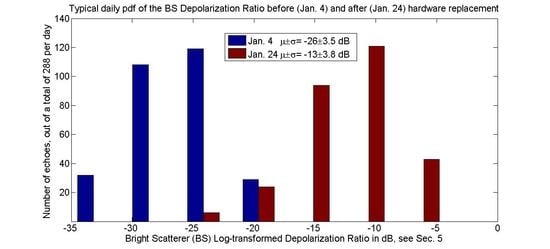On the Spectral and Polarimetric Signatures of a Bright Scatterer before and after Hardware Replacement
Abstract
1. Introduction
- At the end of the tree, a radar reflectivity static map as a conclusive test for few not-yet-classified bins;
- At the beginning of the tree, a test is based on the polarimetric information.
2. Materials and Methods
2.1. The Dual-Polarization Radar Located on Monte Lema at 1625 m Altitude
2.2. The Metallic Tower on Cimetta at 1633 m Altitude: A Peculiar Bright Scatterer
2.3. Physical Radar Observables Used to Characterize the Bright Scatterer
2.3.1. Spectral Moments: Doppler Spectrum Width and Mean Radial Velocity, Wideband Noise Index
2.3.2. The Copolar Correlation Coefficient
2.3.3. The Differential Phase Shift between the Two Orthogonal Polarizations
- A difference in the delay introduced by the scattering of the transmitted wave, known as the backscattering phase shift, δco;
- A difference in the forward propagation velocity of the two polarizations, known as the differential propagation phase, Φdp.
- Of the backscattering phase delay of targets at that range;
- Of the two-way differential propagation phase that occurred when propagating from the radar to the observed target and then back to the radar;
- Of an offset value Ψ0, which is the phase difference between the two transmit vertically and horizontally polarized waves at range zero.
2.3.4. Horizontal and Vertical Polarization Reflectivity; Differential Reflectivity
3. Results
3.1. Stability of the Spectral Moments and of the Wideband Noise Index (with Some, Rare, Exception in 2019)
3.2. On the Remarkably Large and Stable Characteristic of the Copolar Correlation Coefficient (But Not in January 2020)
3.3. On the Small Dispersion of the Differential Phase Shift (But Not in January 2020)
3.4. Some Statistical Characteristic of Radar Reflectivities (and of Differential Reflectivity)
4. Discussion
- Spectrum width perfectly stable and null Doppler velocity (DN = 127 or 128);
- Daily median value of the copolar correlation coefficient larger than 0.993.
- Daily median of the horizontal and vertical polarization reflectivity values expected to be inside the [79.5–83.5] and [77.5–82.5] intervals.
5. Summary, Conclusions and Outlook
- A very small daily standard deviation of the copolar correlation coefficient ρHV, which ranges from 0.007 to 0.0030;
- A very large daily average of ρHV, which ranges from 0.9939 to 0.9986;
- A very small daily standard deviation of the differential phase shift (E{Ψdp} < 9.5°);
- A daily average differential reflectivity between 0.7 dB and 1.9 dB;
- A daily average horizontal reflectivity ranging from 80.28 dBz and 82.54 dBz;
- A daily average vertical reflectivity ranging from 79.20 dBz and 81.54 dBz;
Funding
Institutional Review Board Statement
Informed Consent Statement
Data Availability Statement
Acknowledgments
Conflicts of Interest
References
- Geotis, S.G.; Silver, W.M. An evaluation of techniques for automatic ground-echo rejection. In Proceedings of the 17th Conference on Radar Meteorology, Seattle, WA, USA, 26–29 October 1976; pp. 448–452. [Google Scholar]
- Joss, J.; Lee, R. The application of radar-gauge comparisons to operational precipitation profile corrections. J. Appl. Meteor. 1995, 34, 2612–2630. [Google Scholar] [CrossRef]
- Germann, U.; Joss, J. Operational measurement of precipitation in mountainous terrain. In Weather Radar: Principles and Advanced Applications; Meischner, P., Ed.; Springer: Berlin, Germany, 2004; pp. 52–77. [Google Scholar]
- Gabella, M.; Notarpietro, R. Ground clutter characterization and elimination in mountainous terrain. In Proceedings of the 2nd European Conference on Radar in Meteorology and Hydrology (ERAD2002), Delft, The Netherlands, 18–22 November 2002; pp. 305–311. [Google Scholar]
- Germann, U.; Boscacci, M.; Gabella, M.; Sartori, M. Radar design for prediction in the Swiss Alps. Meteorol. Technol. Int. 2015, 4, 42–45. [Google Scholar]
- Friedrich, K.; Germann, U.; Tabary, P. Influence of Ground Clutter Contamination on Polarimetric Radar Parameters. J. Atmos. Ocean. Technol. 2009, 26, 251–269. [Google Scholar] [CrossRef][Green Version]
- Panziera, L.; Gabella, M.; Germann, U.; Martius, O. A 12-year radar-based climatology of daily and sub-daily extreme precipitation over the Swiss Alps. Int. J. Climatol. 2018, 1–21. [Google Scholar] [CrossRef]
- Steiner, M.; Smith, J.A. Use of three-dimensional reflectivity structure for automated detection and removal of non-precipitating echoes in radar data. J. Atmos. Ocean. Technol. 2002, 19, 673–686. [Google Scholar] [CrossRef]
- Passarelli, R.E.; Romanik, P.; Geotis, S.G.; Siggia, A.D. Ground-clutter rejection in the frequency domain (for radar meteorology applications). In Proceedings of the Preprints of the 20th Conf. on Radar Meteorology, Boston, MA, USA; 1981; pp. 295–300. [Google Scholar]
- Delrieu, G.; Creutin, J.D.; Andrieu, H. Simulation of radar mountain returns using a digitized terrain model. J. Atmos. Ocean. Technol. 1995, 12, 1039–1049. [Google Scholar] [CrossRef]
- Gabella, M.; Perona, G. Simulation of the orographic influence on weather radar using a geometric-optics approach. J. Atmos. Ocean. Technol. 1998, 15, 1486–1495. [Google Scholar] [CrossRef]
- Hubbert, J.C.; Dixon, M.; Ellis, S.M.; Meymaris, G. Weather Radar Ground-clutter. Part I: Identification, Modeling, and Simulation. J. Atmos. Ocean. Technol. 2009, 26, 1165–1185. [Google Scholar] [CrossRef]
- Hubbert, J.C.; Dixon, M.; Ellis, S.M.; Meymaris, G. Weather radar ground-clutter. Part II: Real-time identification and filtering. J. Atmos. Ocean. Technol. 2009, 26, 1181–1197. [Google Scholar] [CrossRef]
- Silberstein, D.S.; Wolff, D.B.; Marks, D.A.; Atlas, D.; Pippitt, J.L. Ground Clutter as a Monitor of Radar Stability at Kwajalein, RMI. J. Atmos. Ocean. Technol. 2008, 25, 2037–2045. [Google Scholar] [CrossRef]
- Bertoldo, S.; Notarpietro, R.; Gabella, M.; Perona, G. Ground clutter analysis to monitor the stability of a mobile X-band radar. In Proceedings of the 9th International Workshop on Precipitation in Urban Areas, St Moritz, Switzerland, 6–9 December 2012; pp. 41–45. [Google Scholar]
- Wolff, D.B.; Marks, D.A.; Petersen, W.A. General Application of the Relative Calibration Adjustment (RCA) Technique for Monitoring and Correcting Radar Reflectivity Calibration. J. Atmos. Ocean. Technol. 2015, 32, 496–506. [Google Scholar] [CrossRef]
- Hunzinger, A.; Hardin, J.C.; Bharadwaj, N.; Varble, A.; Matthews, A. An extended radar relative calibration adjustment (eRCA) technique for higher-frequency radars and range–height indicator (RHI) scans. Atmos. Meas. Technol. 2020, 13, 3147–3166. [Google Scholar] [CrossRef]
- Gabella, M. On the Use of Bright Scatterers for Monitoring Doppler, Dual-Polarization Weather Radars. Remote Sens. 2018, 10, 1007. [Google Scholar] [CrossRef]
- Vollbracht, D.; Sartori, M.; Gabella, M. Absolute dual-polarization radar calibration: Temperature Dependence and Stability with Focus on Antenna-Mounted Receivers and Noise Source-Generated Reference Signal. In Proceedings of the 8th European Conference on Radar in Meteorology and Hydrology (ERAD2014), Garmisch-Partenkirchen, Germany, 1–5 September 2014; 12p. [Google Scholar]
- Gabella, M.; Sartori, M.; Progin, O.; Germann, U. Acceptance tests and monitoring of the next generation polarimetric weather radar network in Switzerland. In Proceedings of the IEEE International Conference Electromagnetics Advanced Applications, Torino, Italy, 9–13 September 2013; 4p. [Google Scholar]
- Gabella, M.; Boscacci, M.; Sartori, M.; Germann, U. Calibration accuracy of the dual-polarization receivers of the C-band Swiss weather radar network. Atmosphere 2016, 7, 76. [Google Scholar] [CrossRef]
- Fabry, F. Radar Meteorology: Principles and Practice, 1st ed.; Cambridge University Press: Cambridge, UK, 2015; 256p, ISBN 978-1-107-07046-2. [Google Scholar]
- Seliga, T.; Bringi, V. Potential use of radar differential reflectivity measurements at orthogonal polarizations for measuring precipitation. J. Appl. Meteor. 1976, 15, 69–76. [Google Scholar] [CrossRef]
- Ulaby, F.T.; Dobson, M.C. Handbook of Radar Scattering Statistics for Terrain; Artech House: Norwood, MA, USA, 1989; 357p. [Google Scholar]
- Matrosov, S.Y. Depolarization estimates from linear H and V measurements with weather radars operating in simultaneous transmission–simultaneous receiving mode. J. Atmos. Ocean. Technol. 2004, 21, 574–583. [Google Scholar] [CrossRef]
- Melnikov, V.; Matrosov, S.Y. Estimations of aspect ratios of ice cloud particles with the WSR-88D radar. In Proceedings of the 36th Conference on Radar Meteorology, Breckenridge, CO, USA, 2013, 16–20 September; 10pAvailable online: https://ams.confex.com/ams/36Radar/webprogram/Paper228291.html (accessed on 27 February 2021).

| Median | Average | St. Dev. | |
|---|---|---|---|
| 6 January 2015 | 0.9954 | 0.9952 | 0.0019 |
| 7 January 2015 | 0.9954 | 0.9952 | 0.0022 |
| 8 January 2015 | 0.9958 | 0.9956 | 0.0018 |
| 11 February 2015 | 0.9972 | 0.9972 | 0.0016 |
| 12 February 2015 | 0.9972 | 0.9968 | 0.0019 |
| Median | Average | St. Dev. | |
|---|---|---|---|
| 3 January 2019 | 0.9987 | 0.9985 | 0.0008 |
| 4 January 2019 | 0.9986 | 0.9985 | 0.0007 |
| 6 January 2019 | 0.9986 | 0.9984 | 0.0008 |
| 7 January 2019 | 0.9985 | 0.9975 | 0.0030 |
| 8 January 2019 | 0.9988 | 0.9986 | 0.0007 |
| Median | Average | St. Dev. | |
|---|---|---|---|
| 20 January 2020 | 0.9773 | 0.9594 | 0.0680 |
| 21 January 2020 | 0.9892 | 0.9812 | 0.0310 |
| 22 January 2020 | 0.9943 | 0.9744 | 0.0627 |
| 23 January 2020 | 0.9947 | 0.9887 | 0.0317 |
| 24 January 2020 | 0.9954 | 0.9812 | 0.0459 |
| Date | St. Dev. | Date | St. Dev. | Date | St. Dev. |
|---|---|---|---|---|---|
| 6 January 2015 | 3.6 | 3 January 2019 | 4.2 | 20 January 2020 | 44.3 |
| 7 January 2015 | 4.4 | 4 January 2019 | 2.5 | 21 January 2020 | 47.2 |
| 8 January 2015 | 3.6 | 6 January 2019 | 4.4 | 22 January 2020 | 76.1 |
| 11 February 2015 | 5.3 | 7 January 2019 | 3.6 | 23 January 2020 | 28.4 |
| 12 February 2015 | 3.5 | 8 January 2019 | 3.6 | 24 January 2020 | 28.9 |
| Date | E{Zh} | Median{Zh} | Median{Zv} | E{Zv} |
|---|---|---|---|---|
| 6 January 2015 | 81.31 dBz | 81.5 dBz | 80.0 dBz | 79.58 dBz |
| 7 January 2015 | 80.28 dBz | 80.5 dBz | 79.5 dBz | 79.20 dBz |
| 8 January 2015 | 80.89 dBz | 81.0 dBz | 80.0 dBz | 79.69 dBz |
| 11 February 2015 | 81.57 dBz | 82.0 dBz | 80.5 dBz | 80.24 dBz |
| 12 February 2015 | 81.26 dBz | 81.5 dBz | 80.5 dBz | 80.31 dBz |
| Date | E{Zh} | Median{Zh} | Median{Zv} | E{Zv} |
|---|---|---|---|---|
| 3 January 2019 | 82.28 dBz | 82.5 dBz | 81.5 dBz | 81.54 dBz |
| 4 January 2019 | 82.54 dBz | 82.5 dBz | 82.0 dBz | 81.80 dBz |
| 6 January 2019 | 81.48 dBz | 81.5 dBz | 80.5 dBz | 80.23 dBz |
| 7 January 2019 | 81.69 dBz | 81.5 dBz | 80.5 dBz | 80.52 dBz |
| 8 January 2019 | 81.93 dBz | 82.0 dBz | 81.0 dBz | 80.87 dBz |
| Date | E{Zh} | Median{Zh} | Median{Zv} | E{Zv} |
|---|---|---|---|---|
| 20 January 2020 | 73.91 dBz | 74.0 dBz | 72.5 dBz | 72.18 dBz |
| 21 January 2020 | 73.88 dBz | 74.0 dBz | 72.0 dBz | 71.64 dBz |
| 22 January 2020 | 73.85 dBz | 75.0 dBz | 72.0 dBz | 71.27 dBz |
| 23 January 2020 | 74.22 dBz | 75.0 dBz | 72.0 dBz | 71.43 dBz |
| 24 January 2020 | 75.25 dBz | 76.5 dBz | 72.0 dBz | 71.55 dBz |
Publisher’s Note: MDPI stays neutral with regard to jurisdictional claims in published maps and institutional affiliations. |
© 2021 by the author. Licensee MDPI, Basel, Switzerland. This article is an open access article distributed under the terms and conditions of the Creative Commons Attribution (CC BY) license (http://creativecommons.org/licenses/by/4.0/).
Share and Cite
Gabella, M. On the Spectral and Polarimetric Signatures of a Bright Scatterer before and after Hardware Replacement. Remote Sens. 2021, 13, 919. https://doi.org/10.3390/rs13050919
Gabella M. On the Spectral and Polarimetric Signatures of a Bright Scatterer before and after Hardware Replacement. Remote Sensing. 2021; 13(5):919. https://doi.org/10.3390/rs13050919
Chicago/Turabian StyleGabella, Marco. 2021. "On the Spectral and Polarimetric Signatures of a Bright Scatterer before and after Hardware Replacement" Remote Sensing 13, no. 5: 919. https://doi.org/10.3390/rs13050919
APA StyleGabella, M. (2021). On the Spectral and Polarimetric Signatures of a Bright Scatterer before and after Hardware Replacement. Remote Sensing, 13(5), 919. https://doi.org/10.3390/rs13050919







